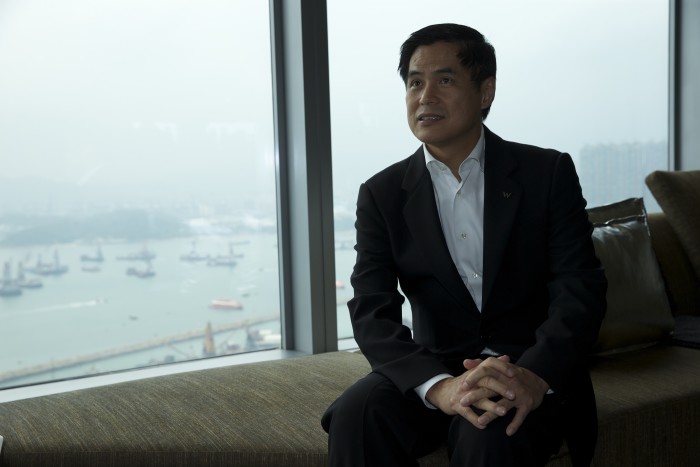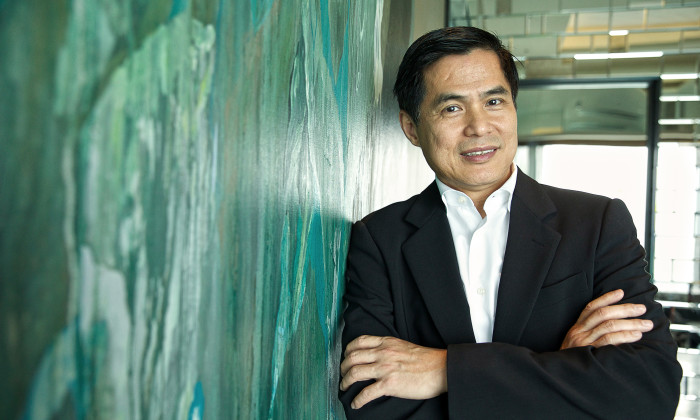



From head chef to head honcho
share on
Starwood’s Asia Pacific president Stephen Ho is not your typical leader of a billion-dollar hotel group. A quiet achiever and risk-taker, this former pastry chef is now fronting an ambitious expansion of the hotel group in some of the world’s biggest growth markets, writes Jennifer Chan.
The 38th floor penthouse at W Hotels is not for the faint-hearted. Surrounded by a wall of windows overlooking Hong Kong’s Victoria Harbour, it is a magnificent, and somewhat intimidating view.
It’s where I’m scheduled to meet Stephen Ho, president of Starwood Hotels’ Asia Pacific operations, but instead we shift to Woobar for a more casual setting.
Ho started his career at Starwood 31 years ago as a pastry chef in Singapore.
The father of three sits at the helm of one of the world’s largest hotels and resorts companies, spearheading the ambitious expansion of the Starwood empire and its collection of brands – Sheraton, W Hotels, St. Regis, Westin and Four Points by Sheraton.

In the past decade, the HKU graduate has added about 150 more hotels, growing the business from less than 12 hotels 10 years ago to almost 200 operating hotels and resorts in the Greater China region.
After three decades of service, he describes his success as a mixture of a feel for new markets and knowing when to seize an opportunity.
“It was not an easy change, but I took the challenge,” Ho says of his move from the kitchen into the office.
“I’ve always had the belief that if things didn’t work out, I can always go back to the kitchen. I was a very successful pastry chef,” he adds proudly.
The opportunity came 12 years ago when he was offered a development position in China, a role he accepted without hesitation.
“I believed in the potential of China earlier before everybody else. I saw the opportunity when I first visited The Great Wall Sheraton.
“The area was very deserted and there was only one building. Then you started to see the growth of the city, you see people starting to change in China.
You have to take risks at times, but more importantly, you have to believe in the market, which makes you stay for the long haul.
“In China, the volume of the population makes you realise there’s a lot of potential.”
Being the world’s second largest economy, China accounts for 50% of Starwood’s business in Asia Pacific, the group’s second largest market after North America.
To make the best out of the hub of the biggest tourism growth market, where 70% of Starwood guests are mostly domestic travellers, the group migrated its headquarters to Shanghai and Beijing for six weeks to back the launch of its fourth and second Sheraton in Shanghai and Beijing, respectively, back in 2011.
“It was done basically to assist the local team, to gain a better understanding of the China market and to spend more time with partners.”
And the momentum continues. The hotel chain is opening an average of 20 to 30 hotels every year in the market.
“When we look five to 10 years down the road, China will overtake the US because there’s a lot happening in China. Understanding the China market is therefore very important.”
In the hotel space, where room occupancy is often considered a hotel performance benchmark, a great deal of effort has been put into diversifying the target market.
The 85% occupancy for the 4,000 rooms at the Sheraton Hotel in Macau, for example, is based upon a wide range of MICE (meetings, incentives, conferences and exhibitions) events for business guests on top of its billion-dollar casino business for leisure guests.
In the same vein, the W brand in Hong Kong also adds up to a 90% occupancy because the 38-storey building is equipped with a handsome Woobar and even a W merchandise store for shoppers, captivating business travellers on week days and leisure seekers on weekends.
But the hotel business still has a great deal of work to do in getting customers to return on a regular basis. In that sense, customer loyalty plays a crucial role in business sustainability, particularly with luxury guests.
Its award-winning loyalty programme – Starwood’s Preferred Guest (SPG) – one of Ho’s proudest products – sits at the centre of its CRM marketing activities within the Starwood empire.
Loyalty is far more than just earning points.
"At Starwood, it’s more about special moments, like birthday surprises or bringing customers to concerts and even backstage, one-on-one ambassador services to handle travel bookings, and taking care also of their (SPG members) families.”
Indeed, the service is exclusive to SPG members, but then again, the company is making an effort to grow the membership base, Ho adds.
“It’s all about personalisation; and technology enables us to deliver personalised service.”
The concept of its newly launched SPG app-supported mobile and keyless entry system, which allows guests to use smartphones as a key, as well as its Apple Watch-compatible bluetooth room key system, certainly achieved what the president keeps emphasising – being innovative – which, again, sounds like another risky plan.
“This kind of innovation may not receive immediate return. But we stay bullish that in the long-run, this initiative will eventually increase customer loyalty under the help of word-of-mouth.”
Like many hotel chains, Starwood is now capturing data from both the hotels and customers about preferences on rooms, diet, music, as well as booking patterns via the SPG online channels and app.
“You need to make sure your guests feel like they’re in the city, and to let them feel they have been recognised, and to let them know that you would take the trouble to understand them during the stay.”
Starwood is serious about this and says it will invest about US$100 million into digital and technology innovation across its global network in the next two years, on top of the US$500 million upgrade which has already been spent.
The hotel chain is also realising the increasingly important role of online travel agents, or OTAs, such as Ctrip, TripAdvisor and Agoda, platforms that account for 20% of the bookings within the Starwood family in Asia.
“Online booking activity is vivid these days. OTAs are like our travel agent partners, and we have to understand each others’ needs to best utilise the platform.”
The key, he stresses, is to strike a balance on brand presence across all platforms, including traditional media and all SPG digital channels – since more than 50% of guests are SPG members.
That being said, the answer to customer loyalty can be found in even the smallest things – staff who speak mandarin, a pair of comfortable slippers or a localised menu.
“Food and beverage are very important to keep the locals. From breakfast to lunch meetings, and dinner for gatherings. It’s important to keep the local population, that’s the only way you can be successful.”
For Ho, personally, he has a heavy dose of wanderlust, and a demanding one.
“Travelling is something you must enjoy. To me, the meaning of travel is to understand not only the city, but also the citizens – of what they eat, and what they do on a daily basis. From there, you gain a better understanding of a city and that may help the business at some point.”
Next March, he along with the whole senior management team, will relocate to India for five weeks to serve the same purpose. Up until now, there are 36 operating hotels under the Starwood umbrella in India with 40 under construction.
His next big project, following the W Beijing launch on 1 November, is an ambitious expansion plan into India next year, a country Ho predicts as the soon-to-be second largest market in Asia, behind China.

For now though, Ho is racing ahead at full steam, with plans to add more muscle to Starwood’s Asia portfolio with the launch of Le Méridien in Bhutan at the end of this year, and another one next year. The two 70 to 80 room boutique hotels may be small, but they are exclusive at US$350 to $400 per night.
His ambition also extends to adventure and ultra-luxury travel, with Starwood’s two biggest brands – Sheraton and W Hotel – opening up in Nepal and Sri Lanka and one St. Regis in Maldives, a vacation spot known for diving and all kinds of adventurous activities.
This aggressive expansion will bring about 10,000 more staff to the Starwood family across Asia.
Ho describes himself as “very bullish” about the overall business environment.
“There will always be challenges. But when you look at the market, people won’t stop travelling.
“There’s a significant increase in median income in the region and it will be those people who will fuel a lot of growth in the Asia Pacific.”
share on
Free newsletter
Get the daily lowdown on Asia's top marketing stories.
We break down the big and messy topics of the day so you're updated on the most important developments in Asia's marketing development – for free.
subscribe now open in new window


